|
- Catalog (in stock)
- Back-Catalog
- Mail Order
- Online Order
- Sounds
- Instruments
- Projects
- History Face
- ten years 87-97
- Review Face
- our friends
- Albis Face
- Albis - Photos
- Albis Work
- Links
- Home
- Contact
- Profil YouTube
- Overton Network
P & C December 1998
- Face Music / Albi
- last update 03-2016
|
In the High Altai, there are numerous petroglyphs (prehistoric rock paintings). Examples, as indicated in the plan below, may be found in the Russian Altai, in the Chuja Steppe - Kalbak-Tash (today partly autonomous Republic Altai), and in the Mongolian Altai in the Aimark Bayan Olgii.

On the basis of research results, there is presently assumed that there are two explanatory theories: The Indo-Iranian theory states that these rock paintings served as illustration for old texts. But there is, however, also a shamanistic interpretation, and here the petroglyphs are considered an expression of old religions and rituals. There have been made out clear interpretations of individual forms like animals, weapons, human beings, carriages etc.
Petroglyphes from prehistoric time are carefully carved in canyons at the foot of sacred peaks in the Altai Mountain range in Western Mongolia (Rock Painting). Drawings were found carved and painted on rocks as well as on cliffs. The motifs are.animals, hunting scenes, and chariots. meditation and ritual scenes of tengerisme (shamanism) of an ancient people. These depict an ancient world dominated by deer, bears, hunters, wolves, and life stock. The engravings measure from a tiny argali sheep of two centimeters, to a life-size horse in full flight. The images are often cut through oxidized rock. Making use of the colors of different layers of the rock to make the carvings stand out from their surroundings. Petroglyphes in Bayan Olgii in Western Mongolia include an image of a deer attacked by wolves, hunting scenes and scores of wild animals. Others depict more domestic scenes of yaks dragging carts, the wheels and horses flattened sideways like hieroglyphs, and two-dimensional herders on horseback.
- see more information about: Petroglyphs and motifs of early shamanism
- see more information about ancient art in Mongolia - History of Mongolian traditional art and artwork
|
Russian High Altai - old petroglyphs
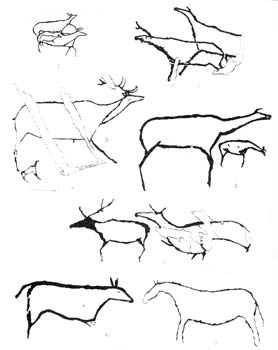
|
Mongolian High Altai - petroglyphs from the
Neolithic Period (Neolithic Age) from 4000 to 1700 BC
and from the Bronze Age from 1700 to 800 BC
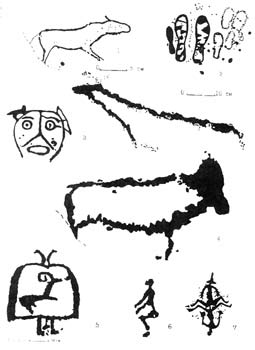
|
Russian and Mongolian High Altai -
petroglyphs from the Scythian Age from 800 to 700 BC
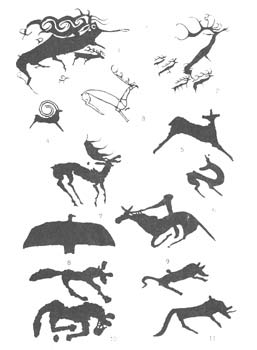
|
Mongolian High Altai -
petroglyphs of animals (representation in pairs)

|
|
Russian and Mongolian High Altai -
petroglyphs in sacred-like representation of animals

|
Russian High Altai -
Graffity from the Hun-Sarmatic Period - 200 BC to 700 AD
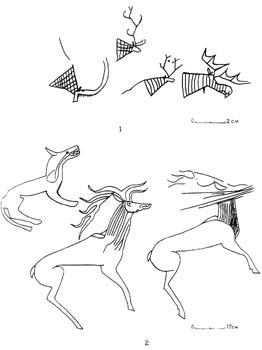
|
Russian High Altai -
Graffity from ethnographic field research
- Ancient Turk Period - 300 to 400 AD
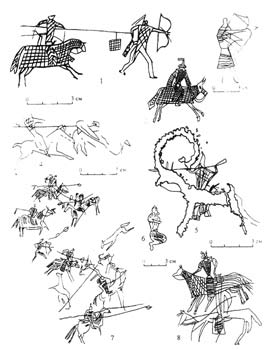
|
Mongolian High Altai -
Graffity from ethnographic field research

|
30'000 years before Christ

Naturalistic art, in which animals are to be represented in their anatomical forms and movements as naturally as possible; it is found on tools and walls in carved as well as painted representation. It is closely linked with magical rites for a successful hunt.
|
Paleolithic Period
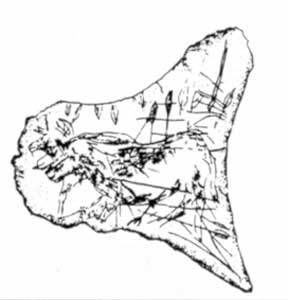
The aim is survival: Big-game hunting by means of traps, but namely by means of stone tools, wooden spears, bow and arrow. Collecting fruits, berries, roots, grass and wild corn. Living in nuclear families, in camps, under rock ledges, in caves. Nomadism.
|
9'000 years before Christ
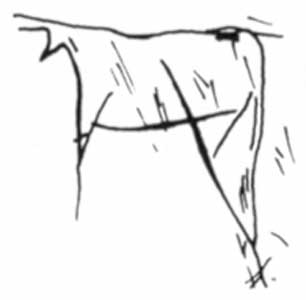
Art in a naturalistic tradition, but always with the aim to simplify the forms, to abstract them and to get rid of all that is not essential; but still rooted in the necessity of a realistic representation.
|
Mesolithic Period
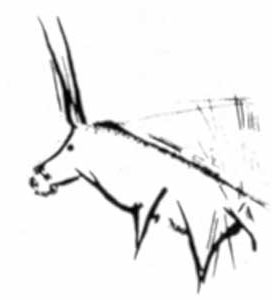
The aim is survival, linked to hunting and collecting fruits. Settlement takes place in natural hiding places or season-related camps.
|
5'000 years before Christ

Symbolic and abstract art, characterized by the stylization of the figures. Man and the sun symbol are the main objects of representation. Scenes with symbolic content also gain narrative value. Art of mural painting, rock painting and graffity on tools made from stone and bones.
|
Neolithic Period
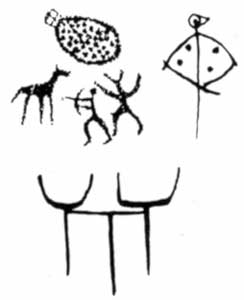
Introduction of agriculture, hence establishment of permanent dwellings. Growth of different kinds of corn. Taming of some kinds of animal. Fabricating and burning of clay vessels. Hunting to secure living. Living in extended families.
|
2'800 years before Christ

Symbolic art, schematic in the Neolithic tradition. Scenes also with narratice features. Compensation of figures in cult scenes. Idealized representation. Development of megaliths.
|
Stone-Copper Age (Aneolithic Period)
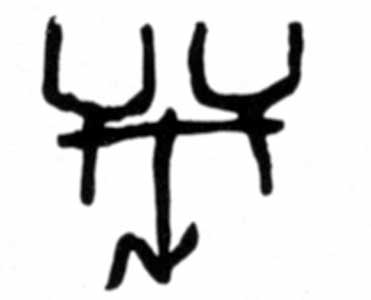
Increase of farming and cattle breeding. Hunting to secure living. Discovery of metals and their processing. Trade.
|
2'000 years before Christ

Schematic and figurative art aiming at resuming the representation in realistic forms. Exuberance of ritual figures and symbols. Noticeable striving for composition and holy rocks of monumental value. The phenomenons of megaliths spread. Scenes also of narrative character which depict situations of the religious as well as physical life.
|
Bronze Age

Introduction of bronze, hence increase of handicraft, trade with raw and finished goods: tools, weapons, and jewellery. Increase of farming and cattle breeding. Consolidation of private property. Construction of the carriage. Hunting. Solid settlements in villages and on poles. Extended families.
|
1'000 years before Christ

Continuation of symoblic art, in connection with fetishist expression. Increase of veristically narrating art in the representation of old human practices, i.e. intellectual, manual, and religious practices. Decadency as a consequence of the contact between Etruscian and Roman civilization in Europe.
|
Iron Age
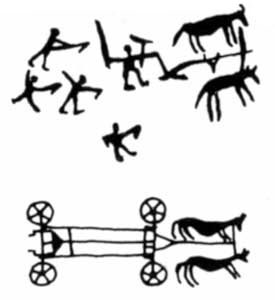
Development of trade. Introduction of iron, hence new impetus on handicraft. Farming, cattle breeding, and hunting in mountainous areas. Solid settlements with agriculture. Mining and establishment of big trading centres. Distribution of mediterranean cultures in Europe.
|
English translation by Hermelinde Steiner
|
